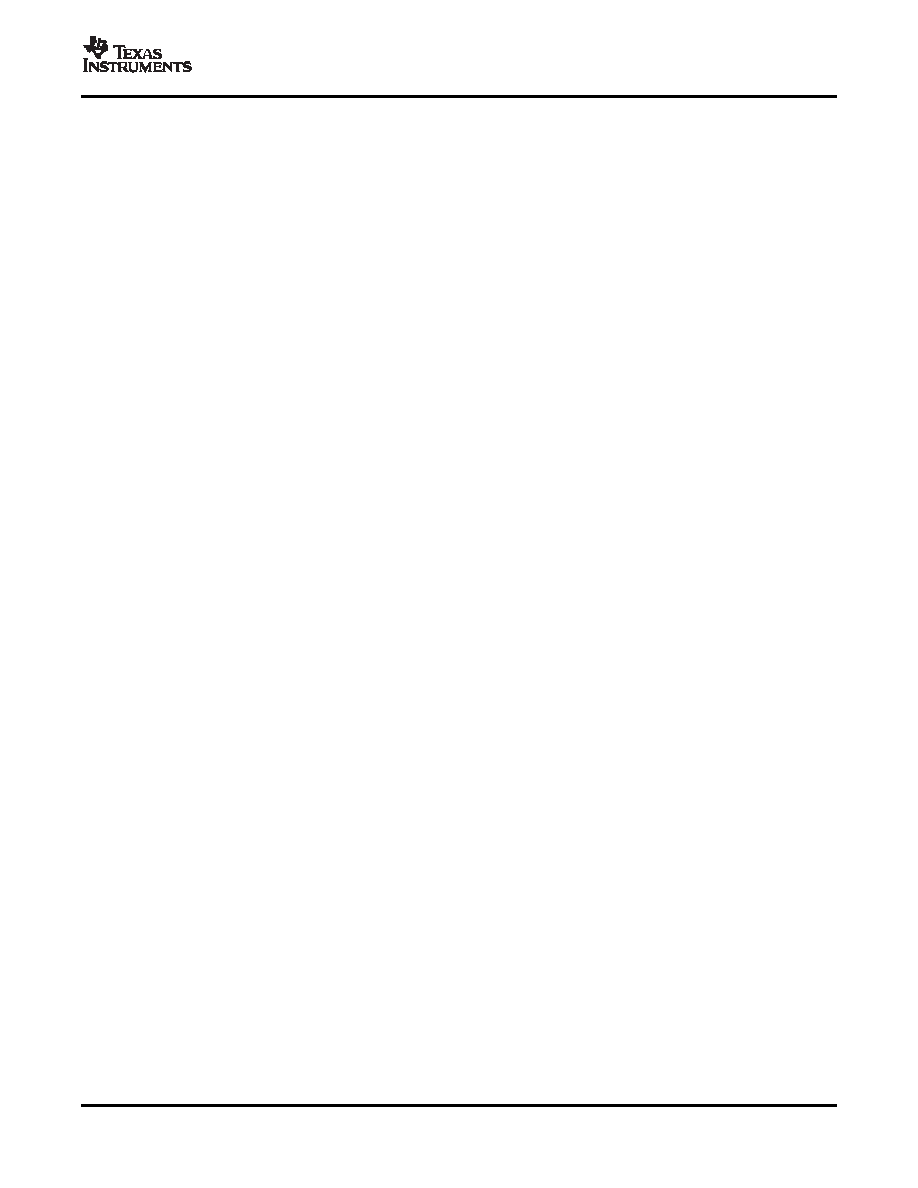- 您現(xiàn)在的位置:買(mǎi)賣(mài)IC網(wǎng) > PDF目錄98229 > THS7316DR (TEXAS INSTRUMENTS INC) 3 CHANNEL, VIDEO AMPLIFIER, PDSO8 PDF資料下載
參數(shù)資料
| 型號(hào): | THS7316DR |
| 廠(chǎng)商: | TEXAS INSTRUMENTS INC |
| 元件分類(lèi): | 音頻/視頻放大 |
| 英文描述: | 3 CHANNEL, VIDEO AMPLIFIER, PDSO8 |
| 封裝: | GREEN, PLASTIC, MS-012AA, SOIC-8 |
| 文件頁(yè)數(shù): | 11/28頁(yè) |
| 文件大小: | 988K |
| 代理商: | THS7316DR |
第1頁(yè)第2頁(yè)第3頁(yè)第4頁(yè)第5頁(yè)第6頁(yè)第7頁(yè)第8頁(yè)第9頁(yè)第10頁(yè)當(dāng)前第11頁(yè)第12頁(yè)第13頁(yè)第14頁(yè)第15頁(yè)第16頁(yè)第17頁(yè)第18頁(yè)第19頁(yè)第20頁(yè)第21頁(yè)第22頁(yè)第23頁(yè)第24頁(yè)第25頁(yè)第26頁(yè)第27頁(yè)第28頁(yè)

www.ti.com
LOW PASS FILTER
SLOS521A – MARCH 2007 – REVISED JANUARY 2008
Each channel of the THS7316 incorporates a 5th-Order Low Pass Filter. These video reconstruction filters
minimize DAC images from being passed onto the video receiver. Depending on the receiver design, failure to
eliminate these DAC images can cause picture quality problems due to aliasing of the ADC. Another benefit of
the filter is to smooth out aberrations in the signal which some DACs can have if their own internal filtering is not
good. This helps with picture quality and helps insure the signal meets video bandwidth requirements.
Each filter in the THS7316 is associated with a Butterworth characteristic. The benefit of the Butterworth
response is that the frequency response is flat with a relatively steep initial attenuation at the corner frequency.
The problem is that the group delay rises near the corner frequency. Group delay is defined as the change in
phase (radians/second) divided by a change in frequency. An increase in group delay corresponds to a time
domain pulse response that has overshoot and some possible ringing associated with the overshoot.
The use of other type of filters, such as elliptic or chebyshev, are not recommended for video applications due to
their very large group delay variations near the corner frequency resulting in significant overshoot and ringing.
While these elliptic or chebyshev filters may help meet the video standard specifications with respect to
amplitude attenuation, their group delay is beyond the standard specifications. Coupled with the fact that video
can go from a white pixel to a black pixel over and over again, ringing can occur. Ringing typically causes a
display to have ghosting or fuzziness appear on the edges of a sharp transition. However, a Bessel filter has an
ideal group delay response, but the rate of attenuation is typically too low for acceptable image rejection. Thus
the Butterworth filter is a respectable compromise for both attenuation and group delay.
The THS7316 filters have a nominal corner (-3dB) frequency at 36-MHz and a –1 dB passband typically at
31-MHz. This 36-MHz filter is ideal for High Definition (HD) 720p and 1080i signals. For systems that oversample
significantly, the THS7316 can also be useful for Standard Definition (SD) NTSC and PAL signals such as
480i/576i Y'P'BP'R, Y'U'V', and broadcast G’B’R’ (R’G’B’) signals. It can also be useful with Enhanced Definition
(ED) signals including 480p/576p Y'P'BP'R, Y'U'V', broadcast G’B’R’ (R’G’B’) signals, and computer video signals.
The 36-MHz -3dB corner frequency was designed to allow a maximally flat video signal while achieving 30-dB of
attenuation at 74.25-MHz – a common sampling frequency between the DAC/ADC 2nd and 3rd Nyquist zones
found in many video systems. This is important because any signal appearing around this frequency can appear
in the baseband due to aliasing effects of an analog to digital converter found in a receiver. Keep in mind that
DAC images do not stop at 74.25 MHz, they continue around the sampling frequencies of 148.5 MHz,
222.75-MHz, 297-MHz, etc. Because of these multiple images that an ADC can fold down into the baseband
signal, the low pass filter must also eliminate these higher order images. The THS7316 has over 50-dB
attenuation at 148.5-MHz, over 50-dB attenuation at 222.75-MHz, and about 55-dB attenuation at 297-MHz.
Attenuation to 1-GHz is at least 36-dB which makes sure that images do not effect the desired video baseband
signal.
The 36-MHz filter frequency was chosen to account for process variations in the THS7316. To ensure the
required video frequencies are not affected, the filter corner frequency must be high enough to allow component
variations. The other consideration is the attenuation must be large enough to ensure the anti-aliasing /
reconstruction filtering is enough to meet the system demands. Thus, the filter frequencies were not arbitrarily
selected.
Copyright 2007–2008, Texas Instruments Incorporated
19
Product Folder Link(s) :THS7316
相關(guān)PDF資料 |
PDF描述 |
|---|---|
| THS7316D | 3 CHANNEL, VIDEO AMPLIFIER, PDSO8 |
| THS7316DG4 | 3 CHANNEL, VIDEO AMPLIFIER, PDSO8 |
| THS7319IZSVR | 3 CHANNEL, VIDEO AMPLIFIER, PBGA9 |
| THS7319IZSVT | 3 CHANNEL, VIDEO AMPLIFIER, PBGA9 |
| THS7360IPWR | VIDEO AMPLIFIER, PDSO20 |
相關(guān)代理商/技術(shù)參數(shù) |
參數(shù)描述 |
|---|---|
| THS7316DRG4 | 功能描述:視頻放大器 3-Ch HDTV Video Amp RoHS:否 制造商:ON Semiconductor 通道數(shù)量:4 電源類(lèi)型: 工作電源電壓:3.3 V, 5 V 電源電流: 最小工作溫度: 最大工作溫度: 封裝 / 箱體:TSSOP-14 封裝:Reel |
| THS7316EVM | 功能描述:放大器 IC 開(kāi)發(fā)工具 THS7316 Eval Mod RoHS:否 制造商:International Rectifier 產(chǎn)品:Demonstration Boards 類(lèi)型:Power Amplifiers 工具用于評(píng)估:IR4302 工作電源電壓:13 V to 23 V |
| THS7318 | 制造商:TI 制造商全稱(chēng):Texas Instruments 功能描述:3-Channel Low-Power EDTV/SDTV Video Line Driver With Low-Pass Filters |
| THS7318_07 | 制造商:TI 制造商全稱(chēng):Texas Instruments 功能描述:3-Channel Low-Power EDTV/SDTV Video Line Driver With Low-Pass Filters |
| THS7318YZFR | 功能描述:視頻放大器 3-Ch L-P EDTV/SDTV Video Line Driver RoHS:否 制造商:ON Semiconductor 通道數(shù)量:4 電源類(lèi)型: 工作電源電壓:3.3 V, 5 V 電源電流: 最小工作溫度: 最大工作溫度: 封裝 / 箱體:TSSOP-14 封裝:Reel |
發(fā)布緊急采購(gòu),3分鐘左右您將得到回復(fù)。